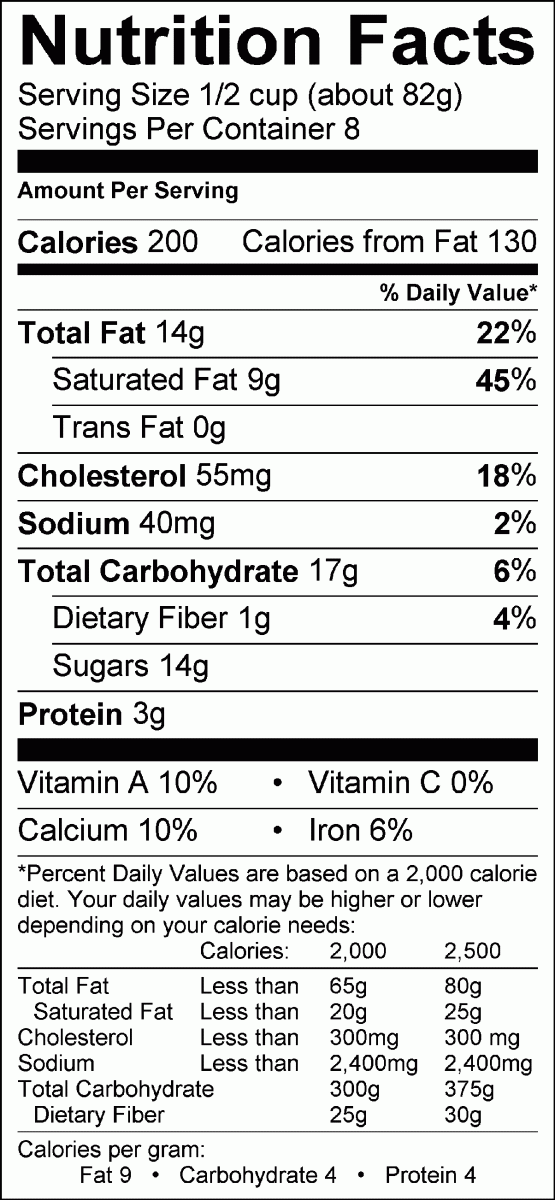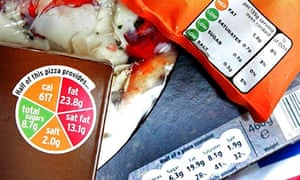39 why are serving sizes standardized on food labels
Improving the design of nutrition labels to promote ... Serving size labels are created by food manufacturers based on Reference Amounts Customarily Consumed (RACC) Per Eating Occasion described in common household measurements appropriate to the type of food. 26, 37, 38 The RACC were originally determined by the FDA based on Nationwide Food Consumption Surveys conducted in the late 1970s and 1980s. Serving Size vs Portion Size Is There a Difference Serving size is a standardized amount of food. It may be used to quantify recommended amounts, as is the case with the MyPlate food groups, or represent quantities that people typically consume on a Nutrition Facts label. Portion size is the amount of a food you choose to eat — which may be more or less than a serving.
How to Read a Food Label - The New York Times Food labels can seem perplexing, and people often read them with an eye toward different things. ... Serving Size: The amount of the ... But even those that do have standardized definitions behind ...
Why are serving sizes standardized on food labels
Food Label Flashcards - Quizlet Serving Size and serving per container Serving sizes are supposed to be standardized to reflect the amt of food people actually eat, but sometimes they are quite unrealistic. How to find out calories # of calories x servings per container 90 x 4 = 360 calories How to find percent of calories from fat calories from fat / calories 30 / 90 = .33 = 33% PDF Understanding Portion and Serving Sizes Serving sizes appear on the Nutrition Facts label and sometimes on the front of food packaging, and they are used to calculate the nutrient information displayed on the label (such as calories, totalfat or dietary fiber per serving). Refer to this image of a Nutrition Facts label as an example. Serving Size on the New Nutrition Facts Label - U.S. Food ... Some serving sizes have changed on the new Nutrition Facts label. By law, serving sizes must be based on the amount of food people typically consume, rather than how much they should consume....
Why are serving sizes standardized on food labels. There's a Difference Between 'Portion Size' and 'Serving ... Portion size refers to how much food you decide to put on your plate when you sit down to eat, while a serving size is the amount of food that's recommended based on the Nutrition Facts label.This amount often does not correspond to the recommended servings in terms of energy content for meals, which are standardized serving sizes. Definition and Importance of the Serving Size | Healthfully The serving size creates a standard reference used on food labels. Importance The standardized serving size is one tool you can use to be sure you're following a healthy, balanced diet. The United States Department of Agriculture determined that nutritional values be contained in the defined serving size. IFIC Study Serves Up Reality Check on Serving, Portion Sizes January 26, 2022 IFIC Study Serves Up Reality Check on Serving, Portion Sizes (Washington, D.C.)— We've all seen "serving size" listed at the top of the Nutrition Facts label. But what exactly does that mean? What about the term "portion size"? The International Food Information Council (IFIC) has conducted a new survey to gauge how much consumers know — and, importantly, whether ... How to Understand and Use the Nutrition Facts Label | FDA Serving sizes are standardized to make it easier to compare similar foods; they are provided in familiar units, such as cups or pieces, followed by the metric amount, e.g., the number of grams (g)....
Who Decides Serving Sizes? | HuffPost Life A serving size is a measurement that allows food manufacturers to create accurate and uniform nutrition labels across brands. It is not a prescriptive size that relates to health. Consumer Survey: Understanding Portion and Serving Sizes ... Regardless of food or beverage category, about half say they try to eat close to the serving size listed on packaging. The top-ranked reasons for paying attention to portion sizes are to help control weight (36% ranked in top 2) and to help avoid eating too much of certain foods (30%). What should I know about nutrition labels and serving sizes? Regardless of how much food is in the bag or box, the nutritional information offers a serving size measurement and all the nutrition information pertaining to that serving size. New smaller bags may still hold more than one serving, so don't assume that a smaller bag or box means that the whole package equals one serving size. Serving Size vs. Portion Size, What's the Difference? A serving size is defined as a standardized, measured amount of food. This is most commonly used by the United States Department of Agriculture (USDA) in reference to food groups or printed on...
A History of What Is Required on Food Labels and the ... The food ingredient panel, serving sizes and terms such as "low fat" and "light" are standardized. This is pretty much the nutrition label as we know it today. 1994: Nutrition Facts panel, basic per-serving nutritional information, is required on most foods under the NLEA of 1990. Food labels are to list the most important nutrients in an ... FDA Proposes Larger -- More Realistic -- Serving Sizes for ... FDA Proposes Larger -- More Realistic -- Serving Sizes for Food Labels The FDA is proposing to change the standard serving sizes to reflect what people actually eat. The FDA defines the current serving sizes as amounts of foods commonly consumed based on dietary intake surveys conducted in the 1970s and 1980s. By Dr. Lisa Young, Contributor Nutrition Facts Matter: What Food Labels Mean (and Why ... Pay extra attention to the serving size. This is often one of the most overlooked items on the nutrition facts label. An official serving may be smaller that you think. A "serving" is different from a "portion." A serving is a measured amount of food. A portion is the amount you decide to actually eat for a meal or snack.[2] New Nutrition Labels from the FDA Make Reading ... - Shape But some food packages contain more than 200 times the RACC, yet people often eat them in one sitting—and that's where the new nutrition labels come in. Packages that someone might "reasonably" consume in one sitting, but that don't technically contain just a single serving, will show the nutrition stats for both one serving and one package. . Specifically, that includes packages that ...
Serving size - Canada.ca Serving size is not necessarily the suggested quantity of food you should eat. The serving size tells you the quantity of food used to calculate the numbers in the nutrition facts table. By checking a product's serving size, you can: understand how much of a nutrient you are eating; compare calories and nutrients between 2 similar packaged food ...
Has the USDA Written a Standardized Definition for a ... Nutrition labels on foods may recommend serving sizes that are slightly different from those on the food pyramid. Before the U.S. Food and Drug Administration adopted new regulations, individual...
The Difference Between 'Portion Size' and 'Serving Size ... It's true that understanding serving sizes helps you make sense of food labels, so that you can get a more accurate sense of the nutritional makeup of your food depending on how many servings you...
Why Are Serving Sizes on Nutrition Labels So Small? The tables are intended to describe the amounts typically consumed in a serving, but the FDA determined these figures before Americans began eating more fatty, sugary, and salty foods. Notice...
The Importance of Reading the Food Label and Nutritional Facts The presence of standardized nutrition labels makes it easy for all of us to compare the contents of similar products and decide which one we would prefer to consume. All labels provide key information about any given packaged food, such as serving size, number of calories, fat content, cholesterol, protein, sugar content, carbohydrates, etc.
Portion Size Versus Serving Size - American Heart Association Serving Size is the amount of food listed on a product's Nutrition Facts label. So all of the nutritional values you see on the label are for the serving size the manufacturer suggests on the package. Once we understand the difference, it's easier to determine how much to serve and easier to teach kids the difference between the two.
FDA Food Labeling Enforcement - LabelCalc Often, food manufacturers tell me that the FDA nutrition labeling rules seem very particular (some even say nitpicky). From label layouts to rounding rules and everything in between, I'll admit the FDA does have some pretty stringent guidelines for proper nutrition labeling. This is, however, for good reason.
Differences between EU and US nutrition labels go far ... In the US, nutritional labels must indicate the number of servings per container - so calories are broken down based on how many slices of bread come in a package, or how many 12-chip portions a...
'Portion Size' and 'Serving Size' Are Not the Same: Why It ... "Serving size" is based on a standardized amount of food or drink which is established by research done on the eating habits of adults and children. Understanding the difference between portion...
Why do food labels have standardized "serving sizes" and ... Why do food labels have standardized "serving sizes" and "servings per container" listed on label? ANSWER 0 colbib ANSWERS: 1-Icy-so you know how much to eat and also tells you how many ppl can eat that amount before it is gone. you have a cup of noodles serving size is 1/3 cup than you can get 3 servings from container. helps with meal ...
Serving Size on the New Nutrition Facts Label - U.S. Food ... Some serving sizes have changed on the new Nutrition Facts label. By law, serving sizes must be based on the amount of food people typically consume, rather than how much they should consume....








Post a Comment for "39 why are serving sizes standardized on food labels"